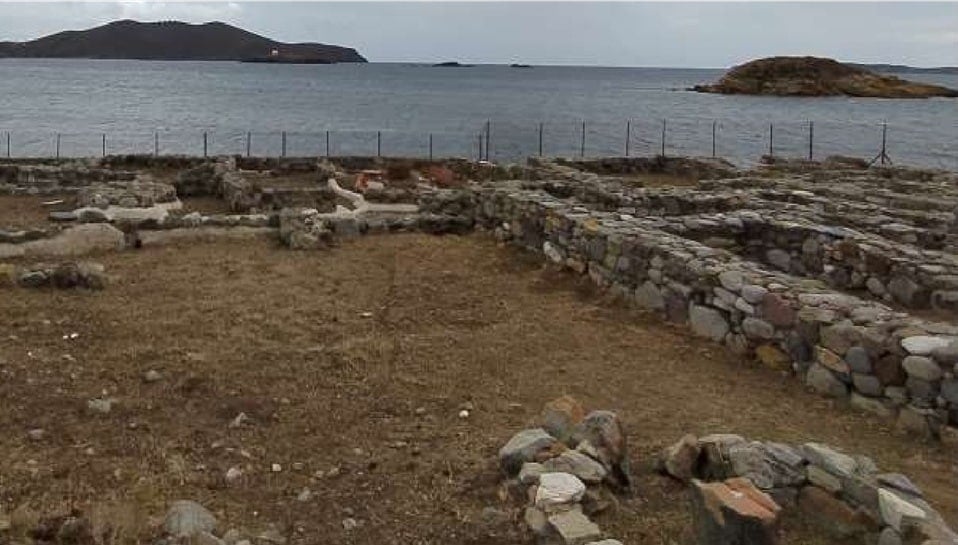

The Ministry of Culture is advancing the conservation, restoration, and protection of building materials and ceramic pithoi at the archaeological site of “Archontiki” on the island of Psara in the eastern Aegean.
The site includes both a Mycenaean settlement and a necropolis, rich in material remains that provide deep insight into the island’s prehistoric and early historic past. Homer, Strabo, Cratinus, Suda and Stephanus of Byzantium all referred to the island, which once stood as a vital stop along the maritime trade routes connecting mainland Greece to the Troad and the Hellespont, as Psyra and Psyrian.
The conservation project includes a thorough study of the site’s environmental conditions, construction materials, structural degradation, and the methodology for their preservation. The effort aims not only to protect the site but to revive its historical significance.

The earliest evidence of habitation at “Archontiki” comes from a simple pit burial dated to the Final Neolithic Period (end of the 4th millennium BC), accompanied by fragmentarily preserved wine jugs.
During the Early Bronze Age, burials furnished with grave vases resembling those known from the Cyclades and the northern Aegean demonstrate the island’s role in broader regional networks.
The extensive Mycenaean necropolis, which dates from 1450–1100 BC, contains primarily box-shaped graves, with a few instances of jar burials.
The most prominent feature of the necropolis is a monumental beehive tomb (tholos), where the buried individual was later venerated as a heroic figure. Early historians recorded this hero cult continuing until the late 5th century BC, featuring offerings of small animals and birds at a low stone altar. The presence of fine pottery from Corinth, Chios, Lesvos, Asia Minor and Attica—dated between the 8th and 5th centuries BC—attests to the long-standing reverence of the site.
Use of the cemetery persisted into the Protogeometric period, indicating its continued cultural and ritual importance.
The necropolis has yielded a remarkable array of pottery in excellent condition. Typical Mycenaean shapes such as stirrup jars, stirrup cups, alabasters, wineskins, ladles and vases are all present. Beyond domestic wares, burials were furnished with prestigious items, including bronze weapons (swords, spears, knives), tools, razors, sickles and sewing needles.
Of particular note is the abundance of seal stones (signets) crafted from cornelian, steatite, faience and glass, along with numerous beads made from the same materials, some even of gold. Figurines, miniature ships and a steatite matrix for crafting rings further underscore the complexity and symbolic richness of the site.
Parallel to the necropolis, a Mycenaean settlement unfolded along the coastal hillside of Karagianni, built amphitheatrically to adapt to the natural terrain. Houses were clustered together in organized blocks, linked by stone-paved paths. The eastern and central portions of the settlement lie about four meters above sea level, while others extend to the shoreline.
The settlement features elongated mansion-like homes, aligned next to each other in terraces across different elevations. Foundations were constructed with beach stones, while superstructures used large earthen bricks. Roofs were supported by vertical wooden beams fixed into stone bases, several of which remain in situ.
Among the most important buildings is a structure containing eight large storage jars (pithoi) in its warehouse area, testifying to the community’s role in storage and possibly trade.
Minister of Culture Lina Mendoni emphasized the island’s overlooked yet profound history:
“The earliest literary reference to Psara is found in Homer’s Odyssey, during the Achaeans’ return from Troy. Despite ancient descriptions portraying the island as barren and impoverished, the archaeological evidence reveals a prosperous Mycenaean trading outpost. The site requires renewed care, as it remains the sole visitable archaeological location on the martyred island of Psara—a crucial link to our cultural heritage.”
Initial excavations were conducted in 1961 by S. Charitonidis, who identified Mycenaean tombs near the sea. Research resumed decades later under the Ephorate of Antiquities, confirming the extent of the necropolis and the existence of a broader settlement.
Today, as conservation teams breathe new life into ancient stone and clay, the story of Psara—an island once considered marginal—is being reclaimed as a center of Aegean cultural memory.
Related: Iconic “Greek Slave” Statue Depicts Orphaned Girl from Greece’s Psara
